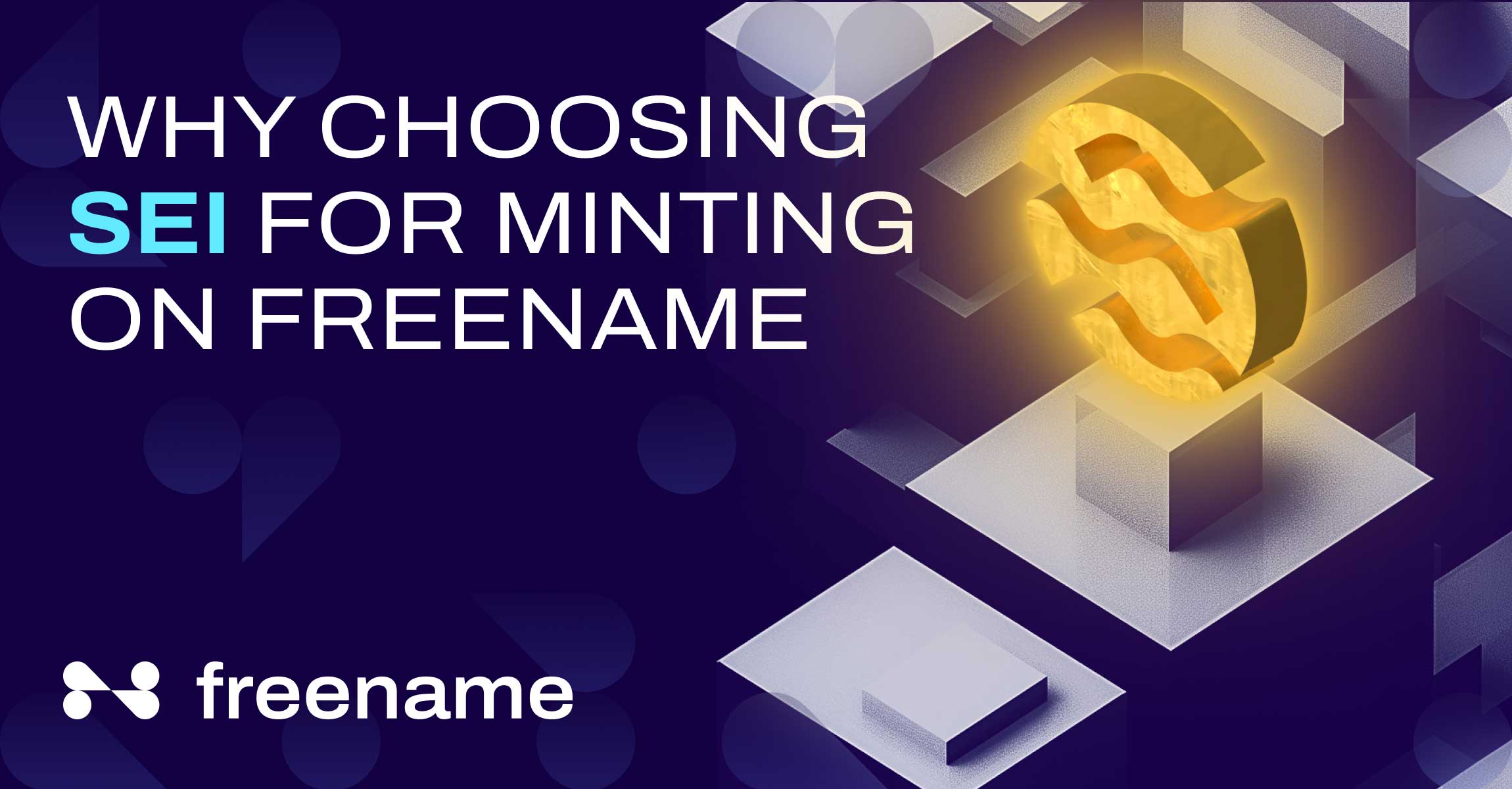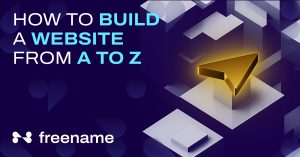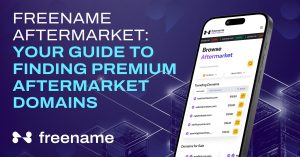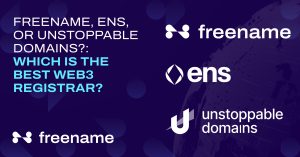Want to mint your digital assets? Freename can help you get started. It is a one-stop shop for digital asset minting, domain name resolution, TLD trademarking, and much more. The Freename ecosystem comprises several different networks where you can mint your digital assets with enhanced security.
If you want to mint digital assets, like Web3 domains, you need a robust blockchain network that promises high transaction processing speeds. The blockchain’s ability to finalize significant volumes of transactions in quick succession helps you save gas fees on minting. If you’re looking for options, try digital asset minting on SEI.
What is SEI? Launched in August 2023, SEI is a high-performance blockchain network that ensures speedy block processing, facilitating market makers, traders, developers, and other end-users. The latest upgrade, SEI v2, boasts a parallelized EVM with Twin-Turbo consensus and an optimized SeiDB. These features make SEI a dynamic blockchain that matches Solana’s speed and scalability and Ethereum’s top-notch integration and security.
SEI enables users to explore the Cosmos SDK and Ethereum ecosystems and deploy contracts and tokens from other blockchain environments to the SEI ecosystem without a hassle. The blockchain’s unparalleled transaction processing speed, scalability, and enhanced security make it an ideal platform for digital asset minting.
Why Choose SEI for Web3 Domains
Let’s analyze SEI’s features, such as scalability, security, interoperability, speed, etc., and see if it is worth minting on SEI.
Scalability
SEI sets high future projections, featuring the latest technologies and advancements, for example:
- It offers an interoperable EVM with 100x performance improvements.
- SEI follows the dPoS protocol, a Twin-Turbo consensus mechanism that ensures consistently low processing speed, even during peak times.
- Finally, the SeiDB offers enhanced read/write capability and supports multi-thread access.
These technologies facilitate a Web2-like experience, making SEI highly scalable for both users and creators. It can accommodate large transaction volumes while keeping transaction fees low and affordable for the users. Moreover, the network allows users to execute existing and new projects without congestion.
Speed
SEI is capable of processing more than 22,000 orders per second. With over 5,000 transactions per second (TPS) and a theoretical TPS of 12,500, it is one of the fastest networks.
On top of that, SEI’s transaction time to finality (TTF) of 0.4 seconds is way better than any other blockchain network. These speed metrics make minting on SEI more feasible and viable.
- Speed allows developers and creators to launch their applications and NFTs faster.
- A high-speed network offers improved UX; hence, onboarding Web3 users becomes easier.
- Trading platforms, such as Automated Market Makers and DeFi exchanges (DEXs) rely on fast processing, block time, and finalization speeds to be able to update block prices in real time.
Security
SEI sets strict standards to ensure the network’s safety and security. The PoS protocol allows delegators and validators to participate in governance and decision-making to strengthen network security. This dual support, along with SEI-supported provisions, helps immunize the network against potential cyber threats.
For example, SEI compels validators to implement best security practices, such as:
- Leveraging Hardware Security Modules to protect private keys
- Using multi-party-computation (MPC) signing services as an added security layer
The network leverages Price Feeders for fair pricing of digital assets to maintain decentralization and transparency. Its native price oracles prevent unfair pricing or malware attacks. Security features remove doubts among network users, ensuring that their digital commodities are safe.
You can maximize the security of your digital assets by minting them with Freename. The platform offers robust security measures to protect your digital assets. These include:
- Periodic audits of smart contracts and infrastructure
- Third-party audits, such as penetration testing, dependency checks, and codebase analysis
- 24/7 monitoring and accident response with tools like Sentry and Snyk
- Adherence with NIST guidelines and OWASP best practices, guarding against cyber security threats
- Protocols for authentication, authorization, API key management, API gateway security, etc.
- Multi-cloud structure
- Implementations related to data protection and privacy.
Cost Efficiency
In Web3, gas fees or transaction fees hold more value than other factors. In general, users consider gas fees one of the critical metrics for determining whether a blockchain is worthwhile.
The gas fees is the amount paid per unit of gas used when a transaction is executed. Users set the gas price, which is used to calculate the cost that validators will receive upon finalization.
Gas Fees = Gas Price x Gas Limit
Several other factors, such as block time, average transaction time, block size, etc., may impact the gas fees. A higher transaction processing time means that the user has to spend more on the transaction.
A typical EVM is not efficient enough because of sequential transaction (non-optimistic) processing. On Ethereum Layer 1, it cannot perform better than 20 transactions per second (TPS). Because of the slow speed, users have to spend hundreds of dollars for simple transactions. This is where SEI is a game-changer.
SEI v2 EVM follows optimistic parallelization, executing multiple independent transactions simultaneously. As a result, the network is able to finalize them much quicker. Considering SEI’s throughput and transaction finality speeds, users can set lower gas prices and save more on online transactions.
With Freename, you can unlock a massive network across the globe. The wider the network, the higher the processing speed, hence lower gas fees.
- For creators, a vast network would mean a quick and cost-effective way to build and deploy dApps on chain.
- For other users, it means they can get SEI tokens (or other coins) within seconds.
Unique Features of SEI
Many features set SEI apart, making it a top choice for digital asset minting. It is aligned with modern-day requirements, ensuring hassle-free transfers and extended support for its users.
User-Friendly Interface
SEI’s interface promises a Web2-like experience. The user-friendly interface allows users to explore the entire SEI ecosystem, giving access to features like:
- SEI Bridge: This tool is interoperable across Wasm and EVM chains. It offers a user-friendly interface that renders seamless asset transfers across blockchains.
- SEI Explorer: Users can get insights into the SEI’s Testnets (atlantic-1 and atlantic-2) and Mainnet (pacific-1). The explorer provides real-time information related to daily, weekly, or monthly transactions and aids users with other valuable resources as well.
- Stake SEI: Meant for overall blockchain security, this tool enables validators and delegators to contribute in governance and decision-making.
A user-friendly interface is vital for interactive usage and learning, especially for beginners. Plus, added documentation and support help experienced users harness the blockchain’s true potential. The aim is to deliver a seamless experience, which, in turn, ensures growth and sustainability.
Interoperability
SEI’s dual environment supports both Ethereum Virtual Machine (EVM) and Wasm ecosystems. The interoperable EVM facilitates existing developers in the Ethereum environment to deploy their projects and contracts with no major changes.
- By leveraging Ethereum-compatible tools, like HardHat and Foundry, developers can deploy their projects on SEI.
- SEI users are able to interact with Ethereum and Wasm ecosystems and transfer their projects with ease.
- SEI offers 100x performance improvements to existing EVM.
Multi-chain interoperability is crucial for digital asset minting, especially NFTs and Web3 domains. It facilitates users to explore opportunities to establish a digital portfolio across different chains.
In this context, Freename can help accelerate your digital asset growth. The platform supports all EVM and non-EVM chains, giving you a massive pool of resources to explore.
Getting Started with Minting Web3 Domains on SEI with Freename
The SEI network is compatible with the Ethereum and Solana chains, so it is automatically added to Freename’s integration list. This means you can easily migrate your Freename or other Web3 domains to the SEI network.
Freename’s multi-chain compatibility and SEI’s interoperable EVM will make it effortless to shift existing Web3 domains and start minting on SEI. Other significant benefits include:
- Freename’s user-friendly interface allows you to buy a domain within minutes.
- Registering with Freename is “as simple as that”. Just visit the website, supply some basic information, and you’re done.
- After registration, you move to the domain minting phase in just a few clicks. The process is seamless.
- Minting and transaction costs on Freename are relatively lower than those on other Ethereum- and Solana-compatible platforms.
- Freename’s added security and vast pool of resources will make minting on SEI safer and quicker.
Conclusion
Minting on SEI through Freename offers a lot of benefits. SEI is scalable, quick, highly secure, and cost-efficient. Freename is a leading platform for domain names and digital asset minting. It offers every kind of assistance, from onboarding to managing your portfolio, and protecting your digital assets from potential threats.
On the other hand, SEI boasts a user-friendly interface, a crucial feature for both new and experienced users. Plus, its interoperability allows you to port domains, tokens, and other digital assets across various blockchains. More importantly, you get lots of integration options for a seamless experience.
It’s time to elevate your presence in the Web3 space with Freename and SEI. Unlock the power of SEI for your Web3 domains on Freename today. To optimize your digital asset potential, you can also explore other compatible chains, such as Solana, Polygon, Aurora, or Base.







